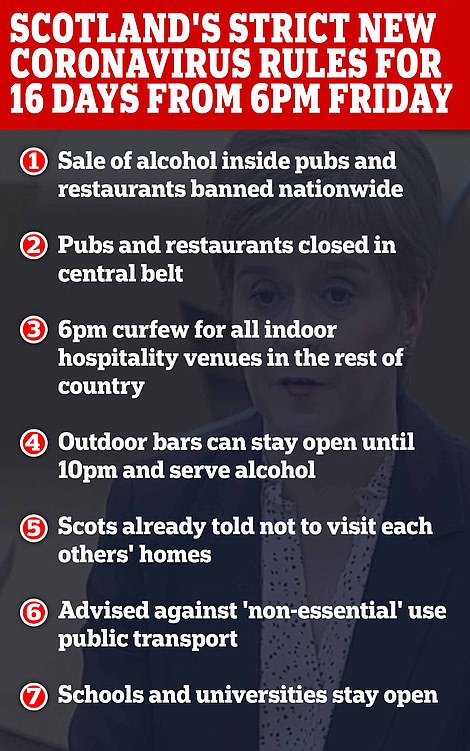Boris Johnson WILL plunge 10 million northerners into tough ‘Tier Three’ lockdown on Monday with pubs and restaurants CLOSED – after Nicola Sturgeon announced two-week restriction in Scotland
- Boris Johnson to announce plans for ‘Tier Three’ lockdown in Manchester, Liverpool and Newcastle next week
- The ‘Tier Three’ lockdown – the highest on a new alert system – will include closing restaurants, pubs and bars
- Nicola Sturgeon yesterday announced a wave of new lockdown measures for Scotland in Holyrood statement
- First Minister declared crackdown on pubs and restaurants selling alcohol and is imposing 6pm closing time
- The Government has been putting together ‘traffic light’ system with three tiers of lockdown to simplify rules
- PM facing mounting Tory MP revolt over 10pm curfew and northern city leaders opposing new restrictions
- UK recorded 14,542 new coronavirus cases yesterday with worrying signs of that hospitalisations are rising
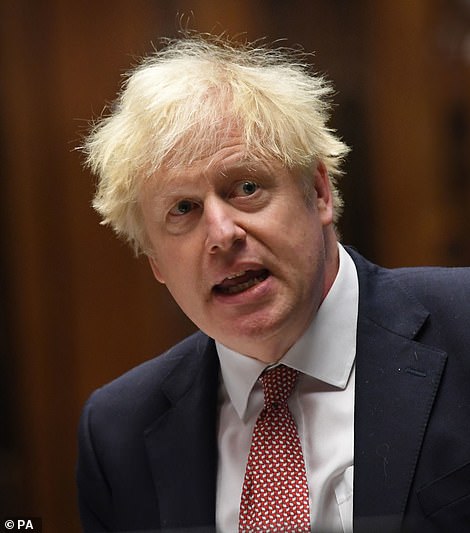
Boris Johnson (pictured) is set to ignore critics and impose Tier Three restrictions – the highest level of a new alert system – in Covid-hit areas of the north
Boris Johnson is set to plunge 10million Northerners into even tougher lockdown restrictions next week, shutting pubs despite an outcry from local leaders and a gathering Tory mutiny.
The PM has signed off a new ‘traffic light’ system of curbs for England after days of bitter wrangling between ministers and scientists, with a swathe of the country where infections have been surging facing the the harshest Tier Three level.
The mechanism for classifying ‘red’ zones are expected are still unclear, but they are expected to cover Manchester, Liverpool and Newcastle – three cities that have continued to see infection rises despite local lockdowns.
Hospitality businesses are set to be shut under the new measures, but shops, offices and schools will stay open.
Ministers are still mulling the fate of hairdressers and leisure facilities in the ‘red’ zones – but there will be special furlough-style compensation for workers and firms hammered by the curbs.
However, there is speculation the PM could have to back down on the blanket 10pm pubs curfew – which critics say is making matters worse – to get the plans through Parliament. Conservative MPs and local leaders in the North have been venting fury about the government’s stance, with former minister Jake Berry accusing the premier of being ‘London-centric’ and enjoying his sweeping emergency powers ‘a little bit too much’.
Politicians in Manchester, Liverpool, Newcastle and Sheffield raged at ‘diktats announced without notice’ and accused ministers of treating the North like a ‘petri dish for experimentation’.
There have been bitter complaints about a North-South divide, with the country starkly split by infection levels and southerners facing far looser controls on everyday life.
The Westminster government is still fighting to avoid a blanket nationwide lockdown similar to that dramatically announced by Nicola Sturgeon yesterday. However, the North will be subject to the same sort of restrictions as in Scotland, where for 16 days pubs and bars are being banned from serving alcohol indoors and must shut by 6pm. In large areas north of the border hospitality venues are being told to shut altogether from tomorrow.
As the coronavirus crisis looks set to escalate again today:
- The leader of Nottingham council leader has voiced alarm at the delay in announcing tighter restrictions to control a surge in the area until the traffic light system is announced on Monday. Labour’s David Mellen said he feared people would have a ‘blow out’ weekend in expectation of the crackdown;
- Nicola Sturgeon has been accused of sentencing thousands of businesses to ‘death’ by imposing a draconian shutdown of pubs and restaurants in Scotland;
- Housing Secretary Robert Jenrick refused to cite scientific evidence for the 10pm pubs curfew, merely saying it was ‘commonsensical’;
- Mr Jenrick hinted that the government could soon urge workers to wear masks in offices, saying the idea had ‘benefits’ and would be considered by the Chief Medical Officer Chris Whitty;
- A leading scientist has voiced alarm at speculation people could be reinfected with coronavirus, saying that could mean the problem is around ‘forever’;
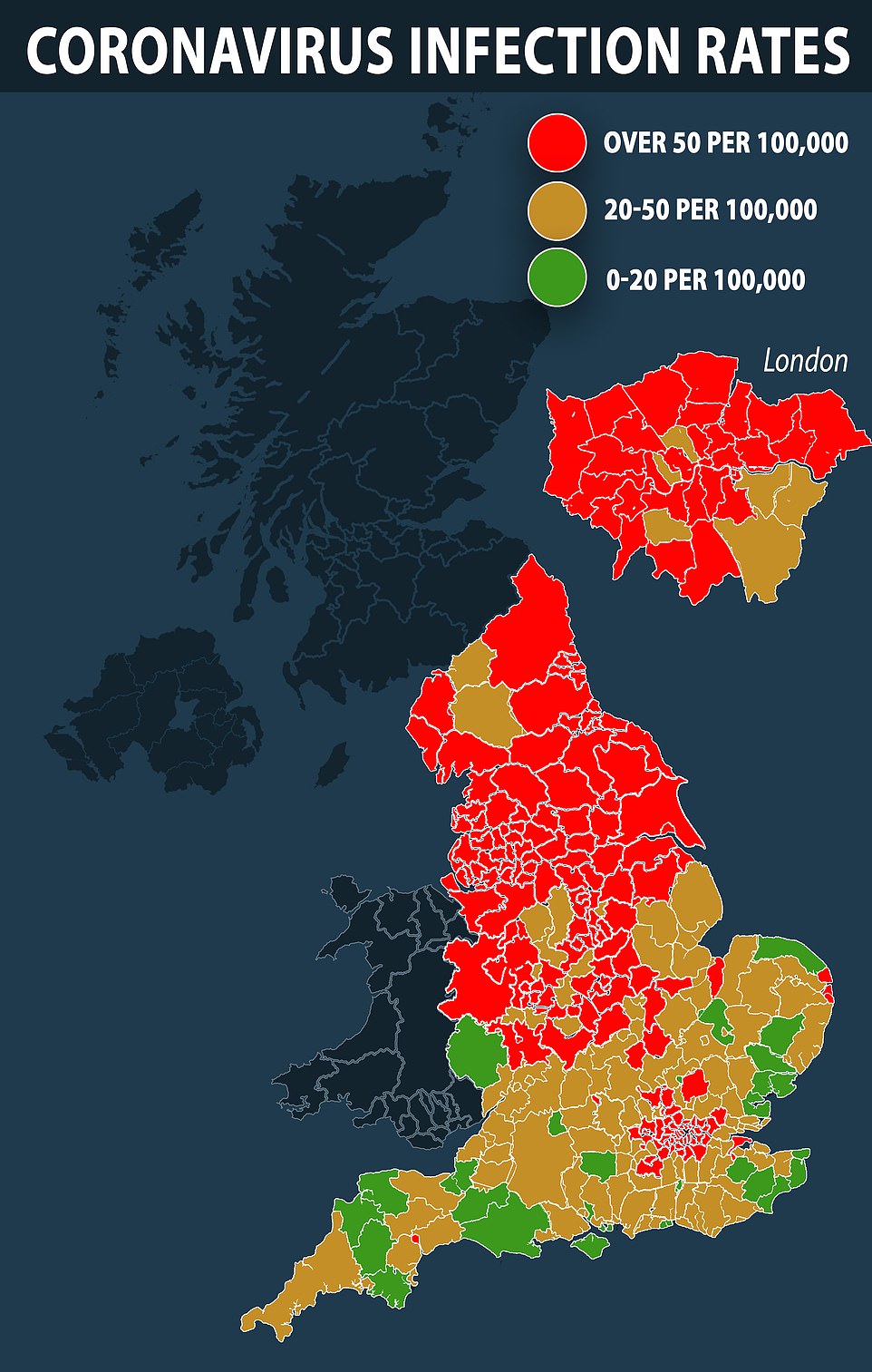

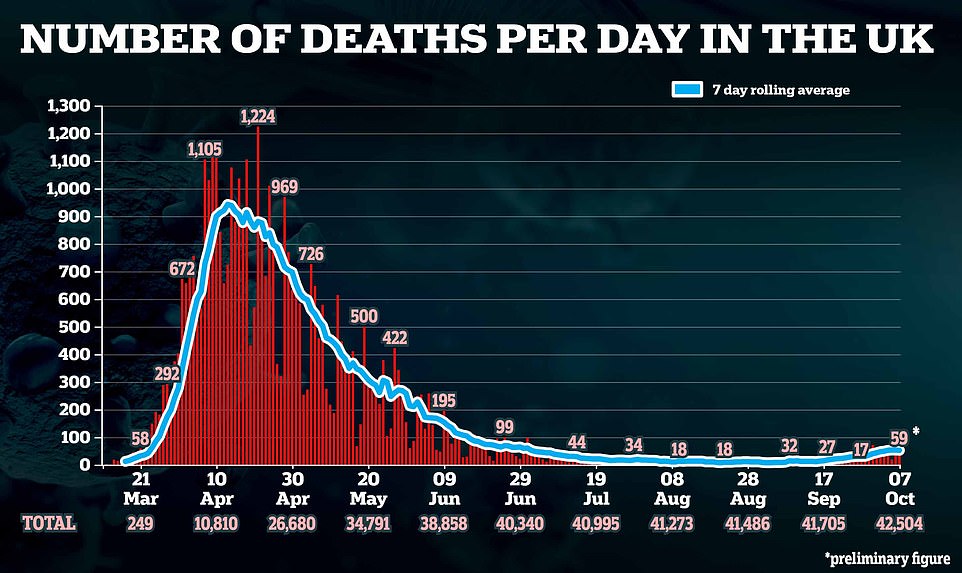
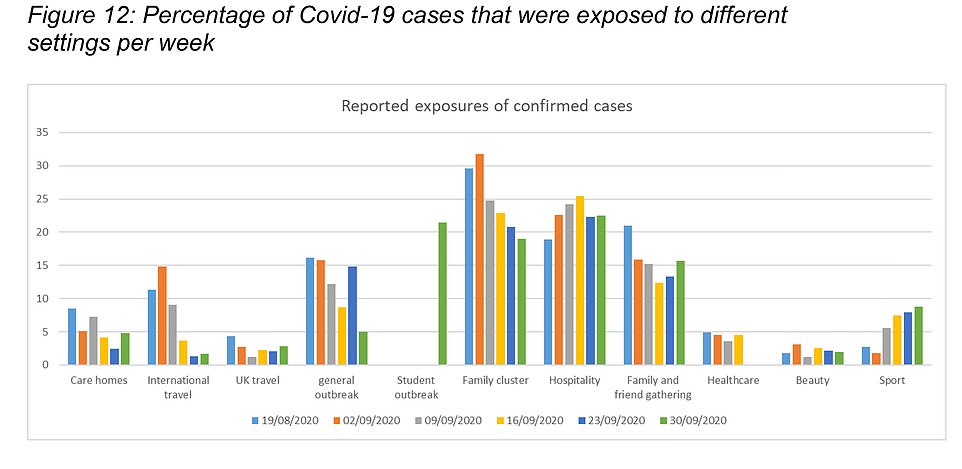
The Scottish government’s figures suggest that hospitality has been a driver of infections over the past week
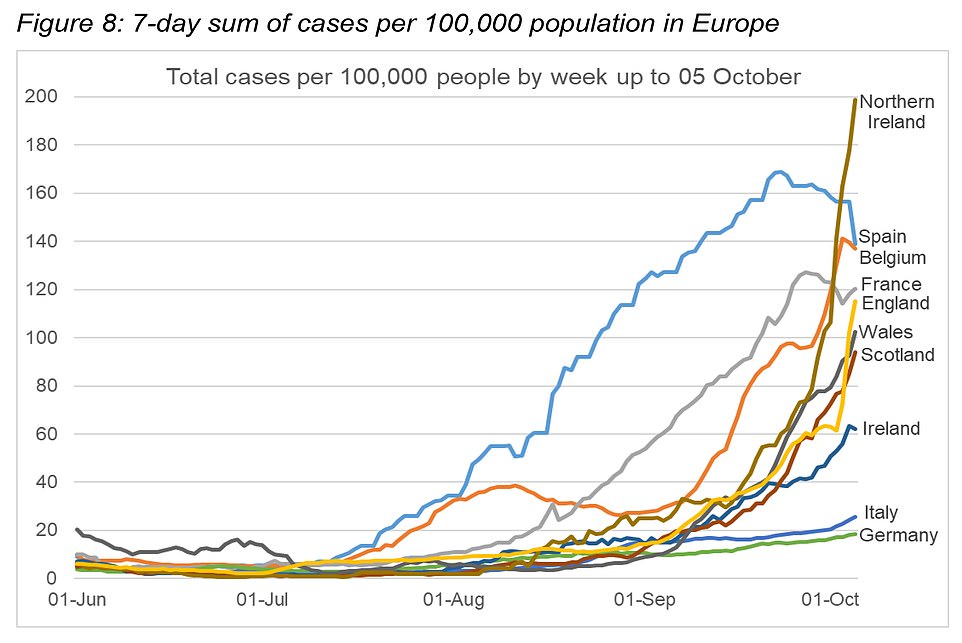
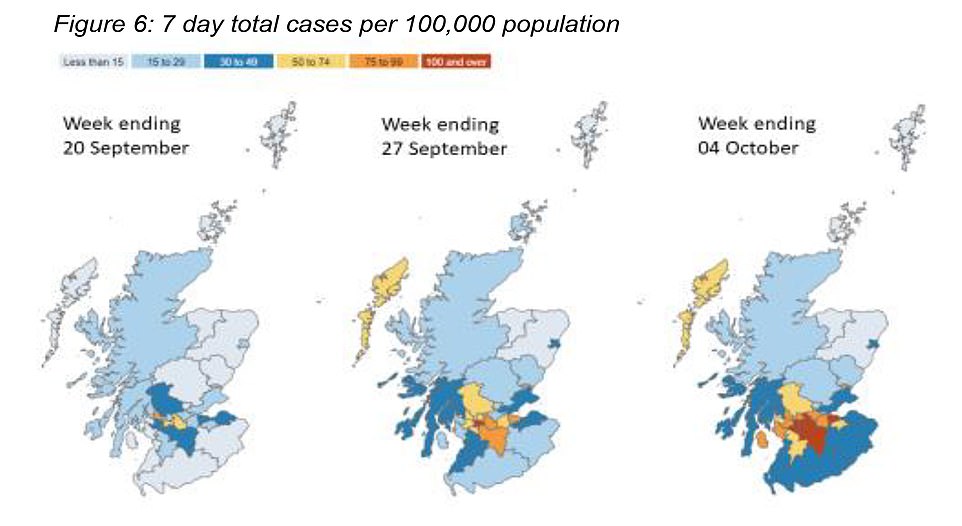
The Scottish government’s latest slides show the growing coronavirus case rate north of the border

Figures tracking the crucial R number for the virus also show an alarming increase since September
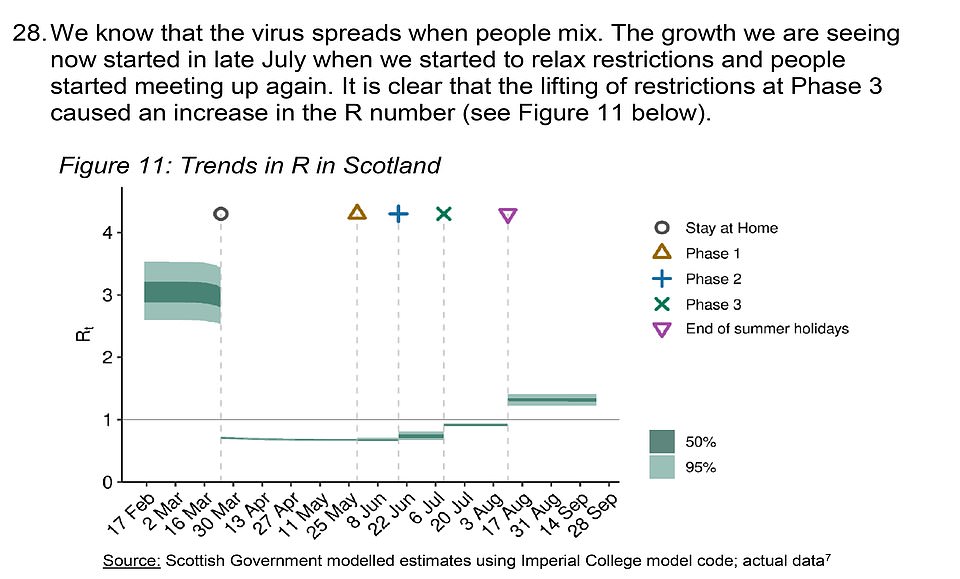
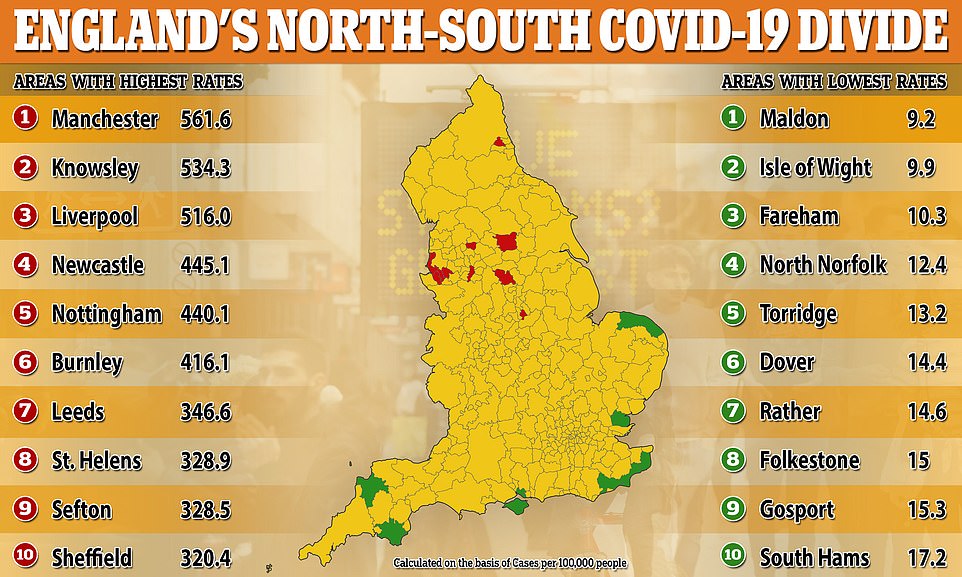
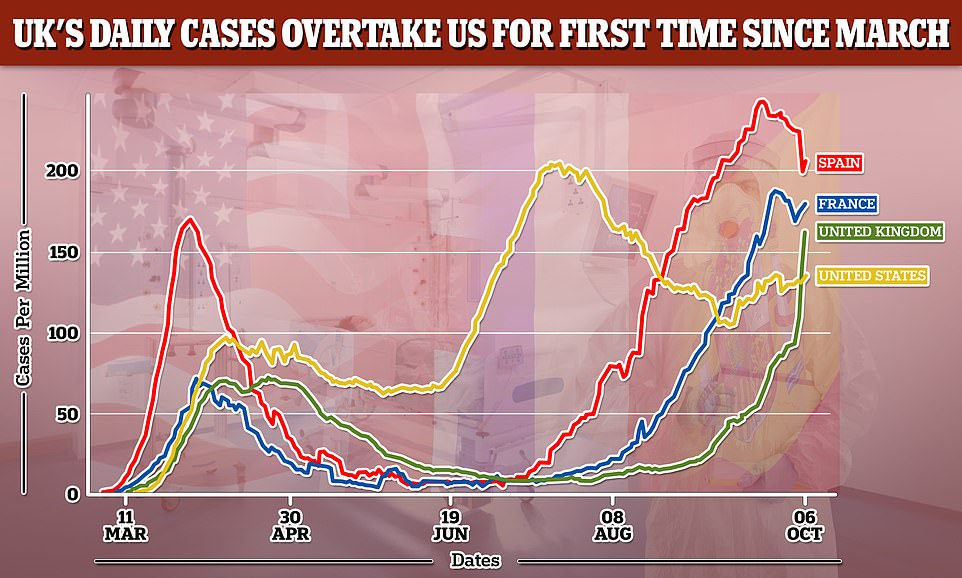
The UK is recording more coronavirus cases relative to the size of its population than the US for the first time since March, data shows. There were 143 cases per million people on October 5, compared to America’s rate of 130 per million

Labour listed 21 areas where the case rate had increased since local lockdowns. However, the party accepted that in Leicester cases had been higher shortly before the restrictions were imposed than after, and so did not include it in the overall tally. Leicester and Oadby & Wigston were counted as one in the final total because they were originally treated as one area when the government brought in the restrictions




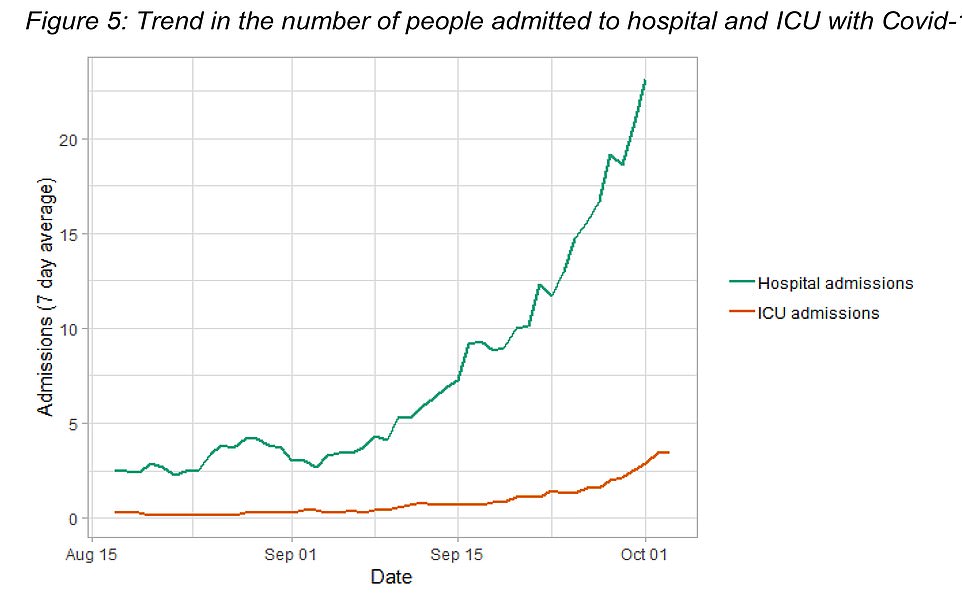

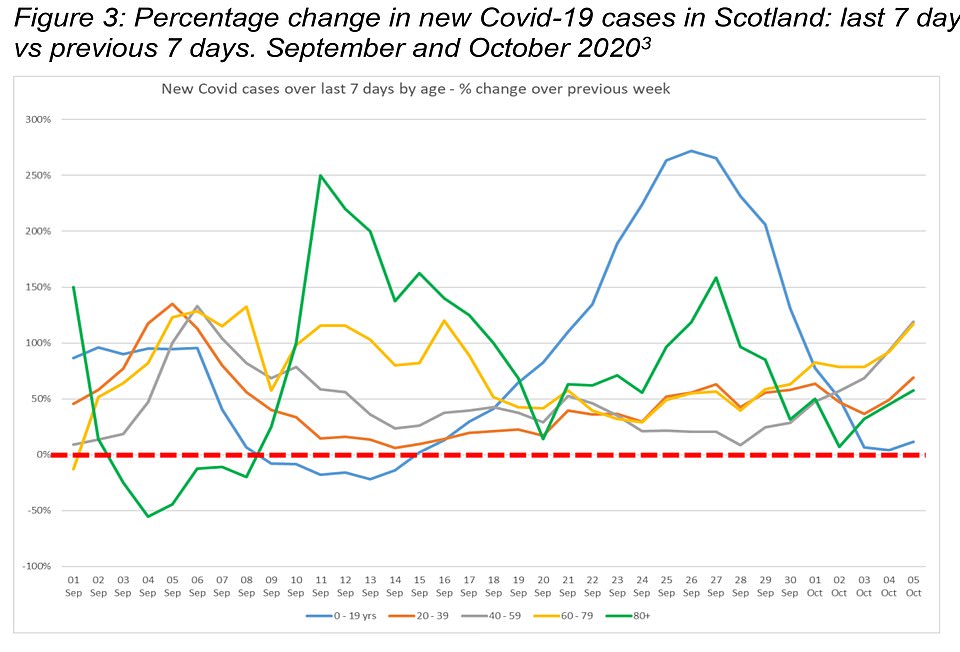

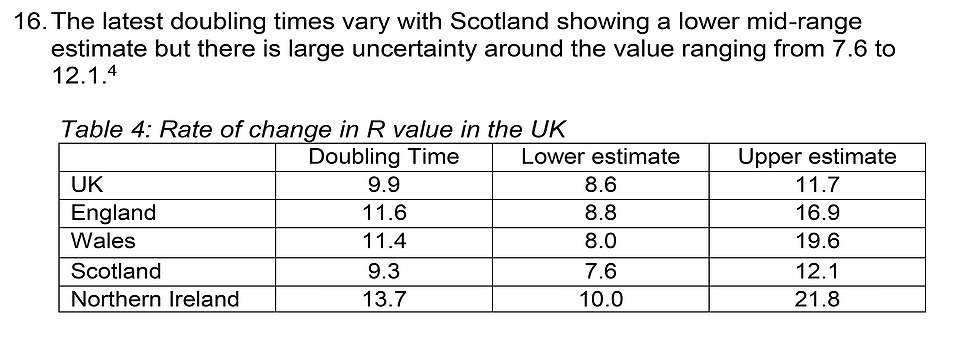
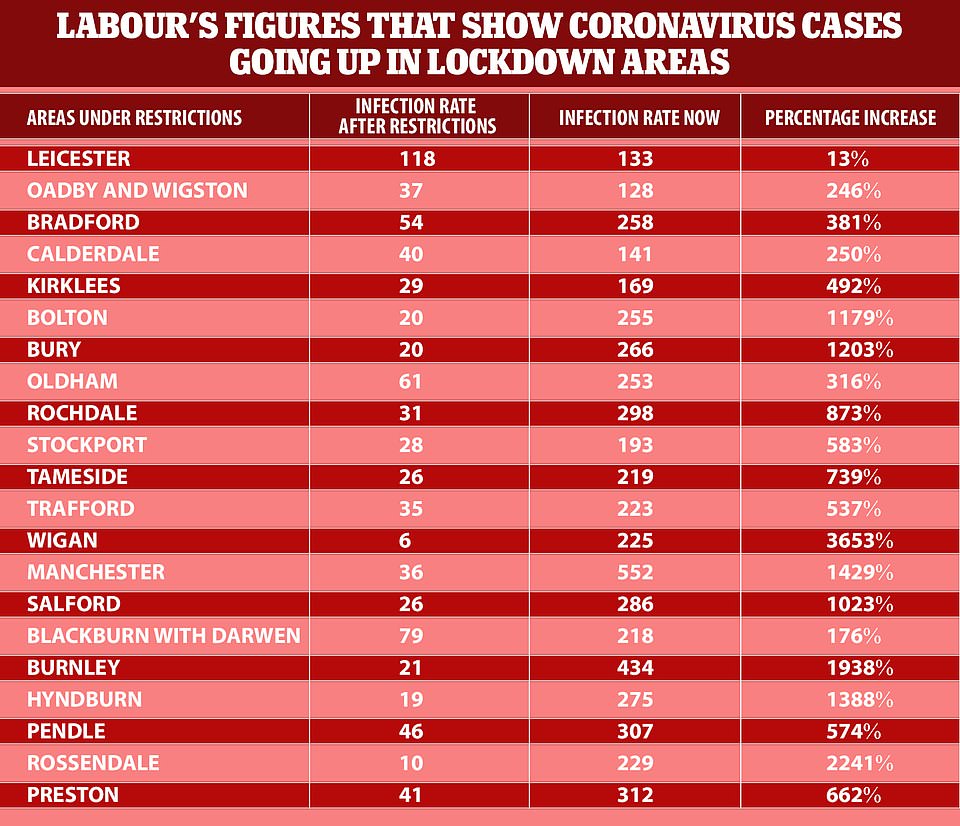
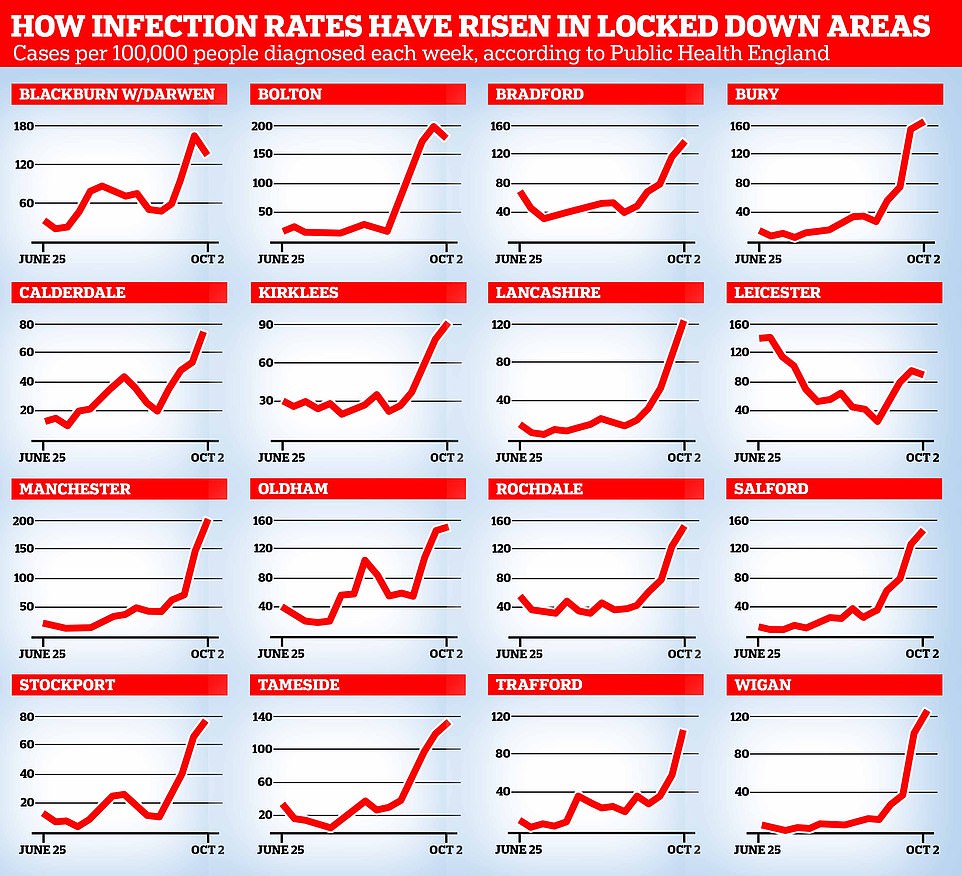
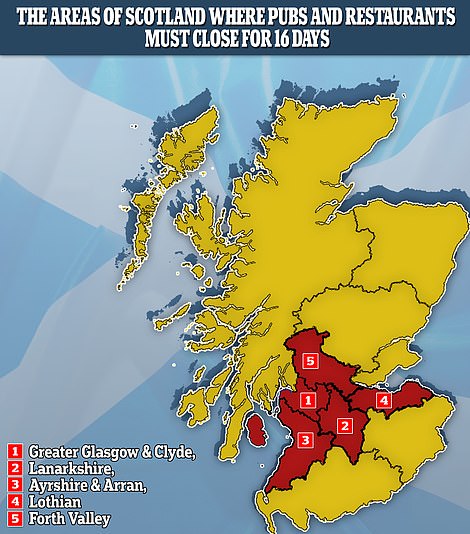
Cabinet divisions led to a delay in the introduction of the new three-tier system, with the overhaul originally set to be introduced today.
Chancellor Rishi Sunak and other ‘hawks’ alarmed about the impact on the economy clashed with ‘doves’ Matt Hancock and Michael Gove over elements of the plan.
Mr Sunak and Business Secretary Alok Sharma pushed for more clarity about the triggers for lockdown and argued that more social distancing restrictions should not be uniformly applied across regions.
On the other hand, Mr Hancock and Mr Gove argued that allowing even minor flexibility would undermine the effort to clarify the public health message.
A meeting on Monday broke up without agreement – but the PM signed off on the new ‘traffic light’ arrangements along with a compensation package last night.
Housing Secretary Robert Jenrick came close to confirming this morning that action is looming on pubs and restaurants.
‘It is correct to say the number of cases in the North West and the North East and a number of cities, particularly in the Midlands like Nottingham, are rising fast and that is a serious situation,’ he said.
‘We are currently considering what steps we should take, obviously taking the advice of our scientific and medical advisers, and a decision will be made shortly.
‘But I’m not able to give you right now exactly what is going to happen.’
Asked if there will be an announcement linked to the hospitality trade next week, Mr Jenrick said: ‘We are considering the evidence. In some parts of the country, the number of cases are rising very fast and we are taking that very seriously.
‘If we do have to take further steps, then obviously we will take very seriously how we can help and support those individual businesses.’
The chancellor is thought to have won the right to be consulted before businesses in the hospitality sector are shut down because of the implications for public spending.
One source told The Times: ‘There’s been unease about the way decisions are happening. It’s opaque. Rishi was pushing for clearer lines.’
UKHospitality executive director for Scotland Willie Macleod today warned that many businesses won’t survive the new restrictions on hospitality and licensed trade in Scotland and said tens of thousands of jobs will be lost.
And Kate Nicholls, CEO of the association in England, urged the government to consider ‘more substantive support’.
She told BBC Radio 4: ‘In Scotland £40million between 16,000 licenced premises equates to just over £2,000 for those people. It barely keeps the lights on let alone saves a job.’
Despite the drastic action on the table, Mr Johnson is facing a desperate battle to stop MPs rejecting the existing 10pm curfew rules across England.
Up to 100 Tory MPs are threatening to vote against the measure, with the government already having delayed the showdown from this week.
The prospect of a government defeat came closer yesterday when Labour leader Keir Starmer demanded more evidence on the effectiveness of the curfew, suggesting his party could oppose it.
Asked for evidence to back up the policy this morning, Mr Jenrick told BBC Radio 4’s Today programme it was ‘common sense’.
‘There is evidence that it plays a role. It is commonsensical that, with a virus that’s transmitted through human contact, the longer one spends with individuals in indoor settings, in a pub or a restaurant, the more likely it is that we spread the virus.’
Asked if the Government would publish scientific evidence regarding the spread of Covid-19 in the hospitality sector, the Housing Secretary said: ‘It is commonsensical that the longer you stay in pubs and restaurants, the more likely you are to come into contact with other individuals.
‘The more drinks that people have, the more likely that some people are to break the rules.
‘There is evidence guided by the Chief Medical Officer and the Chief Scientific Officer.
‘I think it is right that we take action decisively, rather than waiting for the most detailed epidemiological evidence to emerge.’
To add to the mix of messages, Mr Johnson’s faces anger from city leaders in Liverpool, Manchester and Newcastle, as well as Leeds, who wrote to the Prime Minister yesterday urging him not to impose tougher measures.
But the pressure to do so mounted substantially yesterday when Ms Sturgeon announced similar two-week restriction in Scotland. Health Secretary Matt Hancock also hinted England could follow Scotland’s lead in imposing tougher restrictions and pub closures in Covid-hit cities.
However former Cabinet minister Sir Iain Duncan Smith warned Mr Johnson there would be a major Tory rebellion if he copied Ms Sturgeon’s lockdown plans.
He told the Sun: ‘There is no evidence that this works- absolutely none whatsoever.
‘What there is evidence for is this will cripple the economy and lead to more deaths, as has already been demonstrated from non-Covid issues. It’s time to get some balance and save our economy.’
Dr Helen Stokes-Lampard, the chair of the Academy of Medical Royal Colleges which represents the UK and Ireland’s 24 medical royal colleges, said that people need to strictly follow restrictions or the NHS could be ‘unable to cope’.
She told BBC Breakfast: ‘Given the recent dramatic spike in both the number of cases and hospital admissions it is clear that we could soon be back to where we were in April if we are not all extremely careful.’
In another warning, she revealed that the number of people in hospital with Covid-19 over the past month has increased from a ‘few hundred people per day’ to ‘thousands’.
She said: ‘So right now, we have got over 3,100 people in hospital with coronavirus around the UK. Actually 500 of those are in ITU (Intensive Therapy Unit) beds, that’s really worrying.
‘A month ago we only had 60 people in the whole of the UK in ITU beds.So we are seeing a very worrying trend at the moment.’
Ms Sturgeon made the announcement of the new measures yesterday as she warned cases have started to surge among the older generation as she banned pubs and restaurants from serving alcohol indoors in Scotland for at least 16 days from Friday.
The First Minister told MSPs at Holyrood that the situation was ‘better than March’, but admitted she needed to take a ‘backward step’ as she unveiled a dramatic ‘circuit breaker’ squeeze to coincide with the school half-term north of the border.
As well as a ban on serving alcohol, hospitality venues will only be allowed to open from 6am to 6pm as Ms Sturgeon said without the crackdown the virus could be ‘out of control by the end of this month’.
But in five ‘hotspot’ areas in Scotland’s central belt, which includes Edinburgh and Glasgow and is home to approximately 70 per cent of the population, pubs will be closed altogether apart from takeaways until October 26 and people will be advised against using public transport.
Mr Hancock appeared to pave the way for a similar localised crackdown on pubs in England as he said that ‘outside your household and socialising between households, the highest place in incidence of likely transmission, measured by where people have contacts, is unfortunately hospitality’.
However, a targeted shutdown of hospitality venues in hotspot areas appears more likely than a nationwide approach, with Downing Street still committed to its strategy of local lockdowns in specific areas where the virus has spiked.
Imposing some of the toughest restrictions in Europe, Ms Sturgeon said that if it was ‘a purely one dimensional decision’ about tackling the disease there would be even harsher action, but she was considering the wider economy and wellbeing.
But it provoked howls of protest from the hospitality industry, who branded the clampdown a ‘total catastrophe’ and warned a swathe of business will go under permanently.
The extraordinary step – which Ms Sturgeon said would be accompanied with £40million of new compensation for stricken firms – came as Scotland reported more than 1,000 new infections in a day.

Nicola Sturgeon (pictured yesterday) has unveiled a dramatic ‘circuit breaker’ squeeze to coincide with the school half-term north of the border
In another drastic move that could pre-empt policy in England, national exams in Scotland are also being abandoned for next year and replaced with teacher assessments. Education Secretary Gavin Williamson is currently only expected to delay the exam season south of the border by three weeks.
Ms Sturgeon’s announcement heaped pressure on Mr Johnson, who was confronted yesterday with damning figures showing local restrictions in England are failing to curb cases, with ministers and advisers at war over what to do next.
At a stormy PMQs session, Mr Johnson stressed the impact of the surge was being felt worst in the North, saying that showed that the Government’s mix of tough local lockdowns and national restrictions like the Rule of Six and 10pm pubs curfew was the right one.
The backing for ‘differentiated’ measures in England indicates that the premier is still resisting calls from scientists for a blanket crackdown – in an apparent boost for Cabinet ministers alarmed over the threat to millions of jobs and civil liberties.
But Labour leader Keir Starmer launched a furious attack on Mr Johnson in the Commons, saying 19 out of 20 areas subjected to local curbs over the past two months have actually seen infections rise. He insisted that the measures were ‘not working’, and singled out the controversial 10pm curfew on pubs saying the government had failed to provide any ‘scientific basis’.
Under the new system, Tier One will be the basic restrictions as they are now across Britain, including the Rule of Six and the 10pm hospitality curfew.
Tier Two would be tighter measures, roughly in-line with current restrictions in the cities under local lockdown, and will be imposed if Tier One measures are not working or if there is a significant spike in an area.
Though yet to be finalised, Tier Three is set to include the complete closure of pubs and restaurants and strict rules on social interaction – though schools and places of worship are set to stay open.
Tier Three restrictions would be linked to enhanced financial support packages – and possibly a local furlough scheme if bars and restaurants are ordered to be shut.
The tensions between ministers was underlined yesterday with Mr Hancock telling business leaders that hospitalisation rates have risen ‘really quite sharply’ and the Government has a ‘very serious problem on our hands’.
But Trade Secretary Liz Truss suggested that the current balance of restrictions was ‘right’ in a round of interviews.
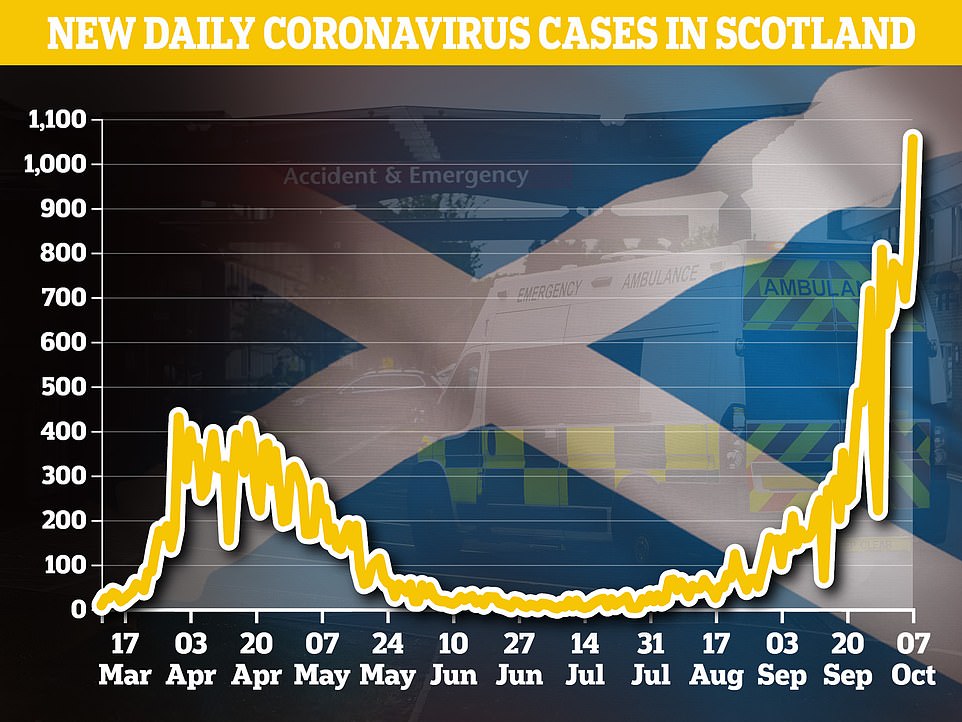
The number of daily cases in Scotland has risen from under 300 two weeks ago – when a ban on households mixing indoors was introduced – to see 1,054 reported yesterday
Ms Sturgeon said that indoor hospitality venues will only be allowed to operate between 6am and 6pm daily, selling food and non-alcoholic drinks only.
Outdoor bars, restaurants and cafes will be allowed to remain open up until 10pm and will be allowed to sell alcohol up to that time.
The restrictions will come into force at 6pm on Friday and are intended to end after October 25.
However, all licensed premises in the Greater Glasgow and Clyde, Lanarkshire, Ayrshire and Arran, Lothian and Forth Valley health board areas will be closed for both indoor and outdoor operations.
Cafes without a licence to sell alcohol will be allowed to open until 6pm, the First Minister said, to counter social isolation.
People in the central belt of Scotland have been asked to avoid public transport unless absolutely necessary in the next two weeks.
While a travel restriction is not being enforced on people in those five areas, Ms Sturgeon urged those living in these areas not to travel beyond their own health boards.
Ms Sturgeon insisted it was her ‘firm intention’ that the clampdown will end after two weeks.
‘It is our firm intention these measures will be lefted at the end of two weeks… but obviously it stands to reason we will moitor the virus between now and then.’
She said: ‘Let me be clear. We are not going back into lockdown today.
‘We are not closing schools, colleges or universities.
‘We are not halting the remobilisation of the NHS for non-Covid care. And we are not asking people to stay at home.
‘So while the measures I announce today will feel like a backward step, they are in the interests of protecting our progress overall.
‘It is by taking the tough but necessary action now, that we hope to avoid even tougher action in future.’
Scottish government modelling released yesterday suggested that without ‘further intervention’ the daily number of coronavirus cases could reach 35,000 by Christmas.
The number of daily cases has risen from under 300 two weeks ago – when a ban on households mixing indoors was introduced – to see 1,054 reported yesterday.
In bruising clashes with Sir Keir in the Commons, Mr Johnson seemed to close off the possibility of an imminent national clampdown.
‘Although the cases in the country are considerably up across the country this week on last week, the seven-day statistics show that there are now 497 cases per 100,000 in Liverpool, 522 cases per 100,000 in Manchester, 422 in Newcastle,’ he said.
‘The key point there is the local regional approach combined with the national approach remains correct because two-thirds of those admitted into hospital on Sunday were in the North West, North East and Yorkshire.’
But Sir Keir unleashed a tirade, pointing out that the government’s local lockdown were clearly ‘not working’.
‘On care homes, protective equipment, exams, testing. The Prime Minister ignores the warning signs, hurtles towards a car crash, then looks in the rear mirror, says ‘what’s all that about?’ he said.
‘It’s quite literally government in hindsight.’
Sir Keir added: ‘All the Prime Minister has to say is it is too early to say if restrictions are working but it’s obvious that something’s gone wrong here, so what’s the Prime Minister going to do about it?’
The Labour leader pointed out that in Mr Johnson’s own local authority, Hillingdon, there were currently 62 cases per 100,000, and no local restrictions.
‘But in 20 local areas across England, restrictions were imposed when infection rates were much lower. In Kirklees it was just 29 per 100,000,’ he said.
‘Local communities, Prime Minister, genuinely don’t understand these differences. Can he please explain for them?’
Mr Johnson replied: ‘I wish I could pretend that everything was going to be rosy in the Midlands or indeed in London where, alas, we are also seeing infections rise.
‘That is why we need a concerted national effort, we need to follow the guidance, we need hands, face, space, get a test if you have symptoms and obey the Rule of Six.’
Sir Keir insisted that he does support the Government’s Rule of Six.
But he struck a starkly different tone on whether Labour will support the England-wide 10pm curfew on bars and restaurants, which critics say is causing more harm than good as revellers merely spill out on to the streets.
‘The Prime Minister can’t explain why an area goes into restriction, he can’t explain what the different restrictions are, he can’t explain how restrictions end – this is getting ridiculous,’ Sir Keir said.
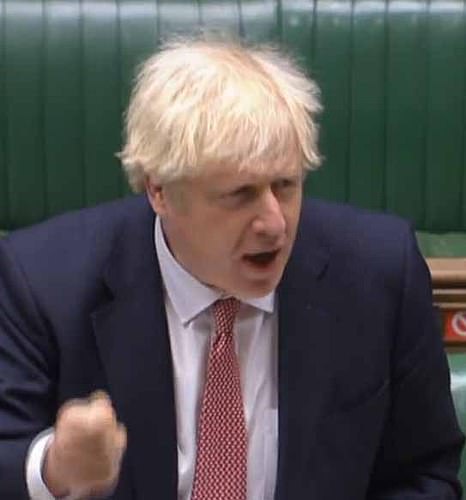
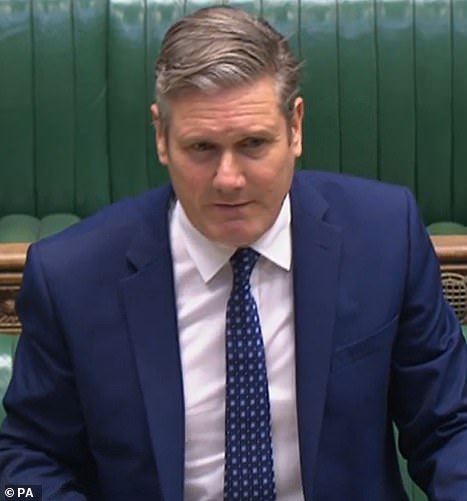
Boris Johnson (pictured left at PMQs yesterday) is desperately trying to balance fears over a surge in infections and hospitalisations, particularly in the North. But Labour leader Keir Starmer (right) said 19 out of 20 area
s subjected to local curbs over the past two months have actually seen infections rise
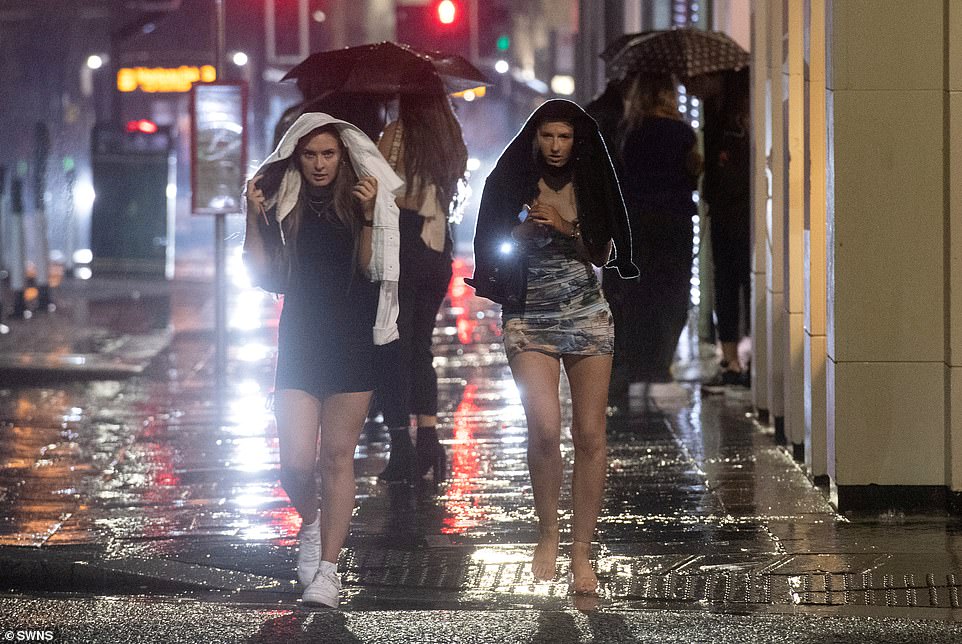
The Prime Minister will reportedly make the announcement despite growing talk of a rebellion among backbench Tory MPs against current restrictions in England – in particular the 10pm hospitality curfew
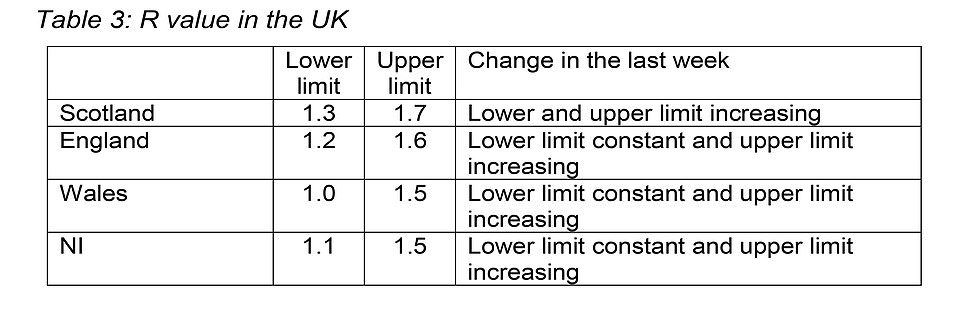
The figures from Scotland estimate that its R number is likely to be higher than in either England or Wales
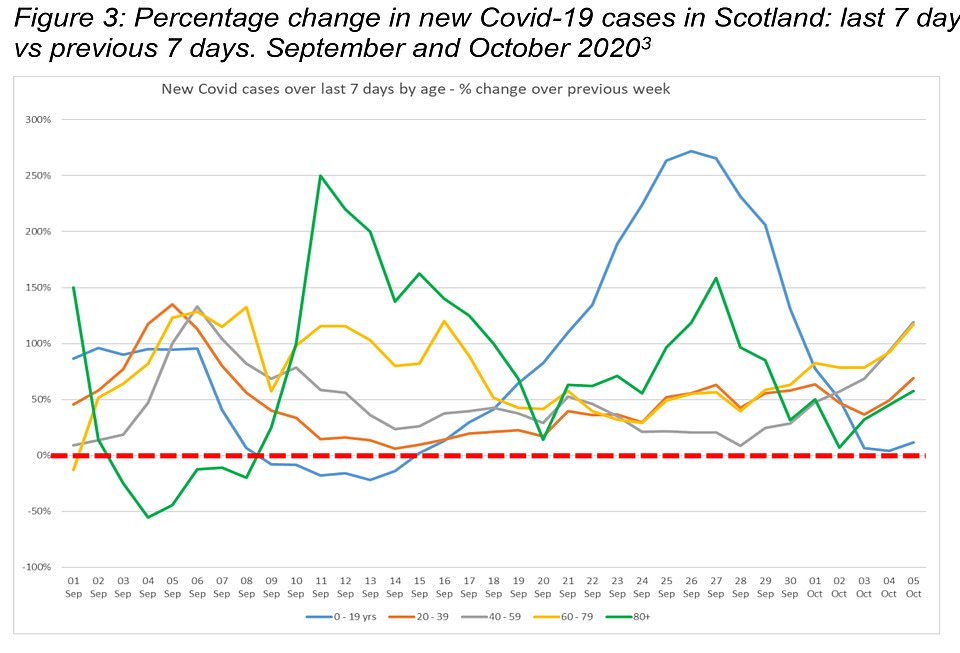
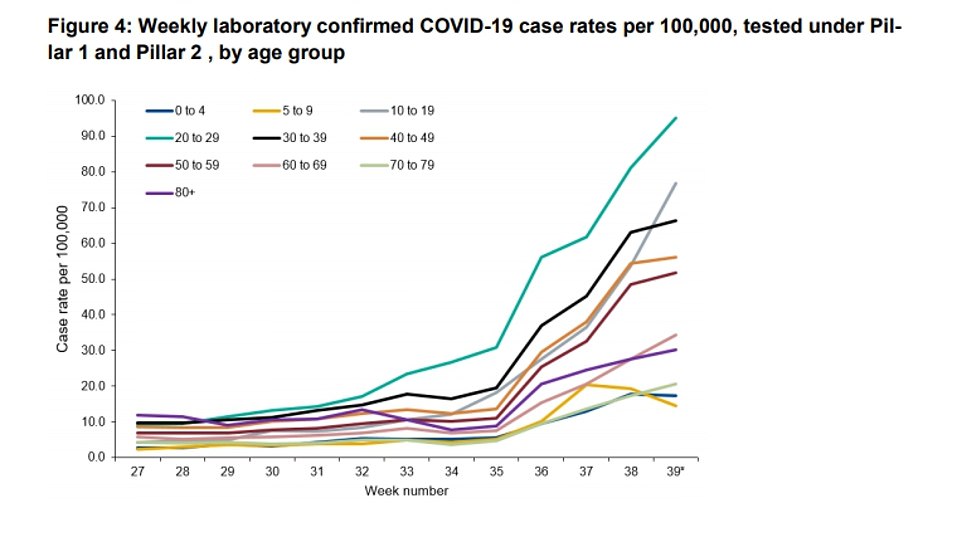
UK government data show that coronavirus cases have been rising among the older generation recently
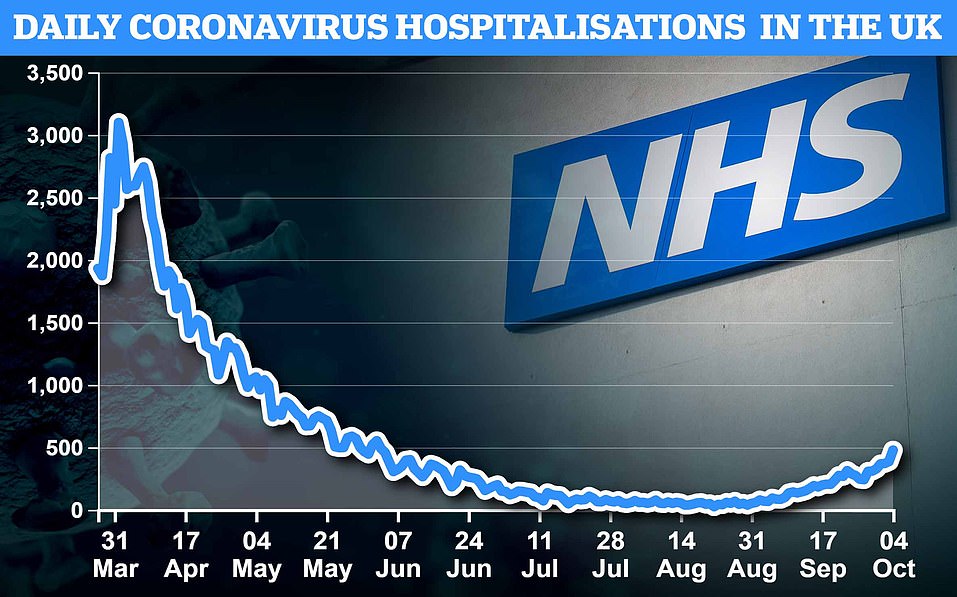

| Adur 29.5 (19), 15.6 (10) | Gloucester 46.5 (60), 18.6 (24) | Rotherham 195.9 (520), 101.0 (268) |
| Allerdale 63.4 (62), 44.0 (43) | Gosport 17.7 (15), 14.1 (12) | Rugby 80.8 (88), 53.2 (58) |
| Amber Valley 74.9 (96), 53.1 (68) | Gravesham 42.1 (45), 20.6 (22) | Runnymede 59.3 (53), 35.8 (32) |
| Arun 24.3 (39), 19.9 (32) | Great Yarmouth 82.5 (82), 63.4 (63) | Rushcliffe 181.2 (216), 48.7 (58) |
| Ashfield 100.1 (128), 50.0 (64) | Greenwich 49.0 (141), 36.5 (105) | Rushmoor 60.3 (57), 23.3 (22) |
| Ashford 23.8 (31), 11.5 (15) | Guildford 66.4 (99), 24.2 (36) | Rutland 85.2 (34), 42.6 (17) |
| Aylesbury Vale 33.6 (67), 15.5 (31) | Hackney and City of London 92.5 (269), 55.0 (160) | Ryedale 102.9 (57), 36.1 (20) |
| Babergh 32.6 (30), 6.5 (6) | Halton 327.6 (424), 265.8 (344) | Salford 304.8 (789), 195.1 (505) |
| Barking and Dagenham 59.7 (127), 62.0 (132) | Hambleton 108.1 (99), 57.9 (53) | Sandwell 112.0 (368), 113.3 (372) |
| Barnet 79.3 (314), 43.2 (171) | Hammersmith and Fulham 72.4 (134), 46.5 (86) | Scarborough 93.8 (102), 47.8 (52) |
| Barnsley 141.4 (349), 76.6 (189) | Harborough 72.5 (68), 43.7 (41) | Sedgemoor 21.1 (26), 16.2 (20) |
| Barrow-in-Furness 193.9 (130), 107.4 (72) | Haringey 84.1 (226), 40.9 (110) | Sefton 350.6 (969), 226.8 (627) |
| Basildon 62.0 (116), 30.4 (57) | Harlow 31.0 (27), 36.8 (32) | Selby 79.5 (72), 66.2 (60) |
| Basingstoke and Deane 27.2 (48), 12.5 (22) | Harrogate 114.4 (184), 65.9 (106) | Sevenoaks 58.0 (70), 15.7 (19) |
| Bassetlaw 84.3 (99), 33.2 (39) | Harrow 82.8 (208), 41.8 (105) | Sheffield 358.2 (2095), 120.9 (707) |
| Bath and North East Somerset 58.5 (113), 37.3 (72) | Hart 43.3 (42), 20.6 (20) | Shropshire 57.6 (186), 42.4 (137) |
| Bedford 68.1 (118), 47.9 (83) | Hartlepool 243.4 (228), 153.7 (144) | Slough 79.6 (119), 82.3 (123) |
| Bexley 51.6 (128), 28.2 (70) | Hastings 38.9 (36), 14.0 (13) | Solihull 114.2 (247), 90.1 (195) |
| Birmingham 151.9 (1734), 147.7 (1687) | Havant 23.0 (29), 22.2 (28) | Somerset West and Taunton 45.8 (71), 9.7 (15) |
| Blaby 89.6 (91), 60.1 (61) | Havering 55.9 (145), 57.4 (149) | South Bucks 64.2 (45), 42.8 (30) |
| Blackburn with Darwen 248.5 (372), 181.0 (271) | Herefordshire 19.7 (38), 13.0 (25) | South Cambridgeshire 50.3 (80), 20.7 (33) |
| Blackpool 177.8 (248), 91.8 (128) | Hertsmere 99.1 (104), 32.4 (34) | South Derbyshire 64.3 (69), 36.4 (39) |
| Bolsover 67.0 (54), 54.6 (44) | High Peak 128.4 (119), 72.3 (67) | South Gloucestershire 55.1 (157), 23.9 (68) |
| Bolton 255.3 (734), 244.1 (702) | Hillingdon 70.4 (216), 57.4 (176) | South Hams 18.4 (16), 18.4 (16) |
| Boston 29.9 (21), 14.3 (10) | Hinckley and Bosworth 67.2 (76), 50.4 (57) | South Holland 31.6 (30), 14.7 (14) |
| Bournemouth, Christchurch and Poole 67.0 (265), 25.8 (102) | Horsham 45.9 (66), 20.2 (29) | South Kesteven 68.8 (98), 26.7 (38) |
| Bracknell Forest 36.7 (45), 25.3 (31) | Hounslow 79.2 (215), 57.5 (156) | South Lakeland 113.2 (119), 47.6 (50) |
| Bradford 282.0 (1522), 184.2 (994) | Hull 92.4 (240), 35.4 (92) | South Norfolk 29.1 (41), 19.9 (28) |
| Braintree 28.2 (43), 21.0 (32) | Huntingdonshire 46.1 (82), 22.5 (40) | South Northamptonshire 38.1 (36), 18.0 (17) |
| Breckland 23.6 (33), 10.0 (14) | Hyndburn 282.6 (229), 236.9 (192) | South Oxfordshire 52.1 (74), 12.7 (18) |
| Brent 74.9 (247), 50.6 (167) | Ipswich 24.1 (33), 7.3 (10) | South Ribble 202.2 (224), 106.5 (118) |
| Brentwood 77.9 (60), 35.1 (27) | Isle of Wight 11.3 (16), 11.3 (16) | South Somerset 23.2 (39), 11.9 (20) |
| Brighton and Hove 59.5 (173), 21.7 (63) | Islington 74.2 (180), 42.9 (104) | South Staffordshire 82.7 (93), 57.8 (65) |
| Bristol 61.1 (283), 27.6 (128) | Kensington and Chelsea 71.7 (112), 23.7 (37) | South Tyneside 266.9 (403), 221.9 (335) |
| Broadland 28.3 (37), 7.6 (10) | Kettering 61.9 (63), 21.6 (22) | Southampton 40.0 (101), 19.0 (48) |
| Bromley 53.9 (179), 27.1 (90) | King’s Lynn and West Norfolk 31.7 (48), 9.9 (15) | Southend-on-Sea 39.3 (72), 31.1 (57) |
| Bromsgrove 104.1 (104), 43.1 (43) | Kingston upon Thames 68.2 (121), 33.2 (59) | Southwark 57.1 (182), 46.7 (149) |
| Broxbourne 45.2 (44), 48.3 (47) | Kirklees 186.5 (820), 118.5 (521) | Spelthorne 66.1 (66), 35.1 (35) |
| Broxtowe 165.7 (189), 61.4 (70) | Knowsley 574.7 (867), 334.7 (505) | St Albans 68.0 (101), 42.4 (63) |
| Burnley 403.7 (359), 373.4 (332) | Lambeth 71.2 (232), 40.5 (132) | St. Helens 332.8 (601), 254.2 (459) |
| Bury 281.7 (538), 216.2 (413) | Lancaster 162.3 (237), 75.3 (110) | Stafford 106.4 (146), 51.0 (70) |
| Calderdale 165.0 (349), 97.4 (206) | Leeds 363.5 (2883), 170.3 (1351) | Staffordshire Moorlands 56.9 (56), 24.4 (24) |
| Cambridge 39.3 (49), 23.2 (29) | Leicester 129.0 (457), 111.5 (395) | Stevenage 27.3 (24), 17.1 (15) |
| Camden 51.1 (138), 27.0 (73) | Lewes 30.0 (31), 16.5 (17) | Stockport 215.0 (631), 109.4 (321) |
| Cannock Chase 59.5 (60), 33.7 (34) | Lewisham 60.5 (185), 34.0 (104) | Stockton-on-Tees 228.5 (451), 100.8 (199) |
| Canterbury 35.7 (59), 24.8 (41) | Lichfield 81.1 (85), 26.7 (28) | Stoke-on-Trent 60.1 (154), 49.5 (127) |
| Carlisle 49.7 (54), 46.9 (51) | Lincoln 81.6 (81), 62.4 (62) | Stratford-on-Avon 71.5 (93), 25.4 (33) |
| Castle Point 43.2 (39), 33.2 (30) | Liverpool 551.6 (2747), 342.3 (1705) | Stroud 25.8 (31), 17.5 (21) |
| Central Bedfordshire 35.0 (101), 23.6 (68) | Luton 59.6 (127), 62.0 (132) | Sunderland 285.6 (793), 215.7 (599) |
| Charnwood 100.6 (187), 51.7 (96) | Maidstone 27.4 (47), 15.1 (26) | Surrey Heath 51.5 (46), 35.8 (32) |
| Chelmsford 45.4 (81), 20.2 (36) | Maldon 16.9 (11), 23.1 (15) | Sutton 33.4 (69), 24.2 (50) |
| Cheltenham 46.4 (54), 29.2 (34) | Malvern Hills 58.5 (46), 34.3 (27) | Swale 36.6 (55), 15.3 (23) |
| Cherwell 50.5 (76), 16.6 (25) | Manchester 541.5 (2994), 307.0 (1697) | Swindon 26.6 (59), 18.9 (42) |
| Cheshire East 135.1 (519), 61.2 (235) | Mansfield 62.2 (68), 39.3 (43) | Tameside 239.7 (543), 174.4 (395) |
| Cheshire West and Chester 135.0 (463), 78.1 (268) | Medway 29.4 (82), 17.6 (49) | Tamworth 58.7 (45), 18.3 (14) |
| Chesterfield 77.2 (81), 29.6 (31) | Melton 76.2 (39), 19.5 (10) | Tandridge 49.9 (44), 26.1 (23) |
| Chichester 28.1 (34), 19.8 (24) | Mendip 31.1 (36), 19.9 (23) | Teignbridge 43.2 (58), 11.2 (15) |
| Chiltern 59.4 (57), 33.4 (32) | Merton 42.6 (88), 26.1 (54) | Telford and Wrekin 53.4 (96), 43.9 (79) |
| Chorley 164.1 (194), 82.9 (98) | Mid Devon 19.4 (16), 9.7 (8) | Tendring 43.7 (64), 11.6 (17) |
| Colchester 30.3 (59), 13.9 (27) | Mid Suffolk 27.0 (28), 6.7 (7) | Test Valley 41.2 (52), 13.5 (17) |
| Copeland 49.9 (34), 39.6 (27) | Mid Sussex 31.8 (48), 19.2 (29) | Tewkesbury 35.8 (34), 17.9 (17) |
| Corby 45.7 (33), 37.4 (27) | Middlesbrough 250.4 (353), 136.2 (192) | Thanet 21.8 (31), 9.9 (14) |
| Cornwall and Isles of Scilly 23.8 (136), 39.7 (227) | Milton Keynes 40.5 (109), 24.9 (67) | Three Rivers 72.9 (68), 37.5 (35) |
| Cotswold 33.4 (30), 11.1 (10) | Mole Valley 58.5 (51), 12.6 (11) | Thurrock 38.4 (67), 24.1 (42) |
| County Durham 193.6 (1026), 110.5 (586) | New Forest 28.3 (51), 19.4 (35) | Tonbridge and Malling 28.8 (38), 12.9 (17) |
| Coventry 102.8 (382), 74.3 (276) | Newark and Sherwood 117.6 (144), 74.3 (91) | Torbay 46.2 (63), 14.7 (20) | Craven 155.8 (89), 138.3 (79) | Newcastle upon Tyne 479.8 (1453), 298.9 (905) | Torridge 16.1 (11), 8.8 (6) |
| Crawley 32.9 (37), 26.7 (30) | Newcastle-under-Lyme 112.8 (146), 50.2 (65) | Tower Hamlets 82.5 (268), 62.5 (203) |
| Croydon 62.3 (241), 32.1 (124) | Newham 70.2 (248), 66.3 (234) | Trafford 259.1 (615), 139.9 (332) |
| Dacorum 56.9 (88), 28.4 (44) | North Devon 25.7 (25), 12.4 (12) | Tunbridge Wells 51.4 (61), 19.4 (23) |
| Darlington 171.3 (183), 103.9 (111) | North East Derbyshire 123.2 (125), 50.3 (51) | Uttlesford 75.6 (69), 49.3 (45) |
| Dartford 28.4 (32), 32.9 (37) | North East Lincolnshire 68.3 (109), 35.1 (56) | Vale of White Horse 50.0 (68), 17.6 (24) |
| Daventry 55.8 (48), 25.6 (22) | North Hertfordshire 48.7 (65), 19.5 (26) | Wakefield 156.2 (544), 86.1 (300) |
| Derby 75.4 (194), 42.8 (110) | North Kesteven 52.2 (61), 35.1 (41) | Walsall 117.3 (335), 83.4 (238) |
| Derbyshire Dales 55.3 (40), 15.2 (11) | North Lincolnshire 87.6 (151), 47.6 (82) | Waltham Forest 71.8 (199), 47.3 (131) |
| Doncaster 136.3 (425), 62.2 (194) | North Norfolk 14.3 (15), 6.7 (7) | Wandsworth 65.8 (217), 37.9 (125) |
| Dorset 24.6 (93), 11.4 (43) | North Somerset 37.2 (80), 27.4 (59) | Warrington 245.7 (516), 197.6 (415) |
| Dover 19.5 (23), 6.8 (8) | North Tyneside 226.5 (471), 156.3 (325) | Warwick 59.1 (85), 37.6 (54) |
| Dudley 73.1 (235), 56.3 (181) | North Warwickshire 53.6 (35), 41.4 (27) | Watford 64.2 (62), 43.5 (42) |
| Ealing 93.6 (320), 55.6 (190) | North West Leicestershire 48.3 (50), 41.5 (43) | Waverley 65.7 (83), 34.8 (44) |
| East Cambridgeshire 26.7 (24), 6.7 (6) | Northampton 53.9 (121), 25.8 (58) | Wealden 27.9 (45), 12.4 (20) |
| East Devon 32.1 (47), 10.9 (16) | Northumberland 177.4 (572), 170.6 (550) | Wellingborough 51.4 (41), 27.6 (22) |
| East Hampshire 40.1 (49), 19.6 (24) | Norwich 43.4 (61), 14.2 (20) | Welwyn Hatfield 48.8 (60), 17.1 (21) |
| East Hertfordshire 75.5 (113), 26.7 (40) | Nottingham 496.8 (1654), 94.3 (314) | West Berkshire 36.6 (58), 22.7 (36) |
| East Lindsey 29.6 (42), 14.1 (20) | Nuneaton and Bedworth 67.0 (87), 48.5 (63) | West Devon 28.7 (16), 9.0 (5) |
| East Northamptonshire 80.4 (76), 18.0 (17) | Oadby and Wigston 126.3 (72), 93.0 (53) | West Lancashire 280.8 (321), 147.0 (168) |
| East Riding of Yorkshire 106.7 (364), 49.5 (169) | Oldham 278.8 (661), 193.6 (459) | West Lindsey 103.5 (99), 26.1 (25) |
| East Staffordshire 50.9 (61), 33.4 (40) | Oxford 110.9 (169), 61.0 (93) | West Oxfordshire 30.7 (34), 15.4 (17) |
| East Suffolk 34.1 (85), 10.0 (25) | Pendle 299.6 (276), 255.1 (235) | West Suffolk 36.3 (65), 8.9 (16) |
| Eastbourne 36.6 (38), 15.4 (16) | Peterborough 56.4 (114), 35.1 (71) | Westminster 67.0 (175), 29.1 (76) |
| Eastleigh 24.0 (32), 10.5 (14) | Plymouth 34.7 (91), 23.3 (61) | Wigan 257.1 (845), 159.7 (525) |
| Eden 31.9 (17), 22.5 (12) | Portsmouth 47.0 (101), 32.1 (69) | Wiltshire 30.8 (154), 15.2 (76) |
| Elmbridge 98.7 (135), 26.3 (36) | Preston 306.7 (439), 223.6 (320) | Winchester 47.3 (59), 16.8 (21) |
| Enfield 68.0 (227), 42.5 (142) | Reading 42.0 (68), 29.7 (48) | Windsor and Maidenhead 76.6 (116), 31.7 (48) |
| Epping Forest 66.1 (87), 51.6 (68) | Redbridge 103.9 (317), 73.1 (223) | Wirral 234.9 (761), 193.5 (627) |
| Epsom and Ewell 62.0 (50), 19.8 (16) | Redcar and Cleveland 169.2 (232), 70.7 (97) | Woking 63.5 (64), 36.7 (37) |
| Erewash 94.5 (109), 39.0 (45) | Redditch 54.0 (46), 48.1 (41) | Wokingham 41.5 (71), 28.6 (49) |
| Exeter 338.6 (445), 54.8 (72) | Reigate and Banstead 32.3 (48), 15.5 (23) | Wolverhampton 73.7 (194), 83.2 (219) |
| Fareham 12.0 (14), 13.8 (16) | Ribble Valley 234.9 (143), 121.5 (74) | Worcester 67.2 (68), 47.4 (48) |
| Fenland 46.1 (47), 9.8 (10) | Richmond upon Thames 103.5 (205), 39.4 (78) | Worthing 22.6 (25), 29.8 (33) |
| Folkestone and Hythe 15.0 (17), 13.3 (15) | Richmondshire 119.1 (64), 83.8 (45) | Wychavon 57.2 (74), 34.0 (44) |
| Forest of Dean 33.4 (29), 20.7 (18) | Rochdale 324.6 (722), 202.3 (450) | Wycombe 44.7 (78), 23.5 (41) |
| Fylde 153.5 (124), 121.3 (98) | Rochford 20.6 (18), 11.4 (10) | Wyre 125.8 (141), 91.0 (102) |
| Gateshead 232.1 (469), 162.3 (328) | Rossendale 249.0 (178), 159.5 (114) | Wyre Forest 65.2 (66), 52.3 (53) |
| Gedling 124.7 (147), 39.0 (46) | Rother 12.5 (12), 16.7 (16) | York 192.3 (405), 72.6 (153) |
| Name of local authority; rate of new cases in the seven days to October 4; number (in brackets) of new cases recorded in the seven days to October 4; rate of new cases in the seven days to September 27; number (in brackets) of new cases recorded in the seven days to September 27 | ||

